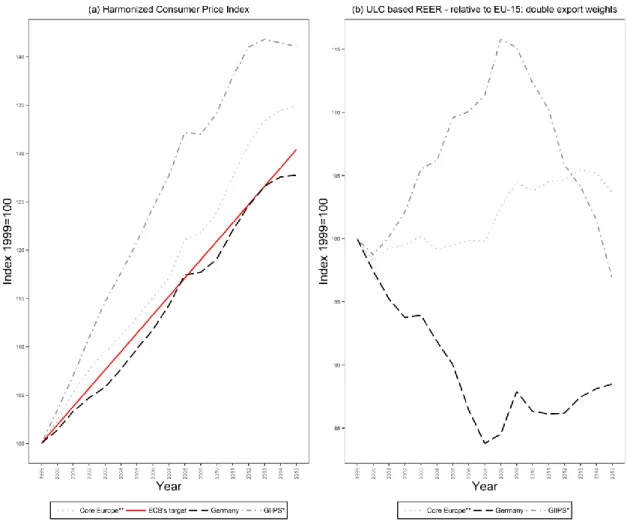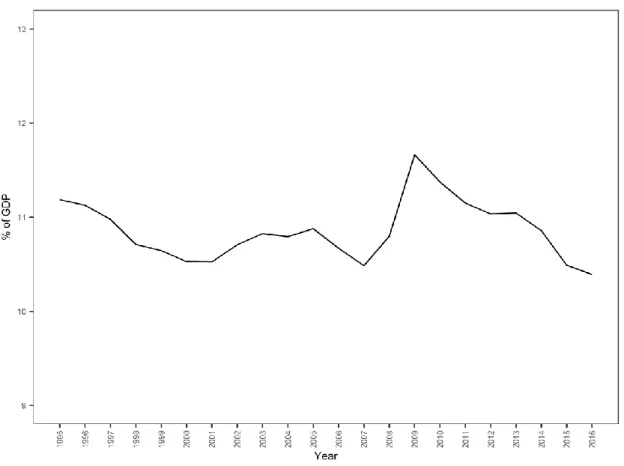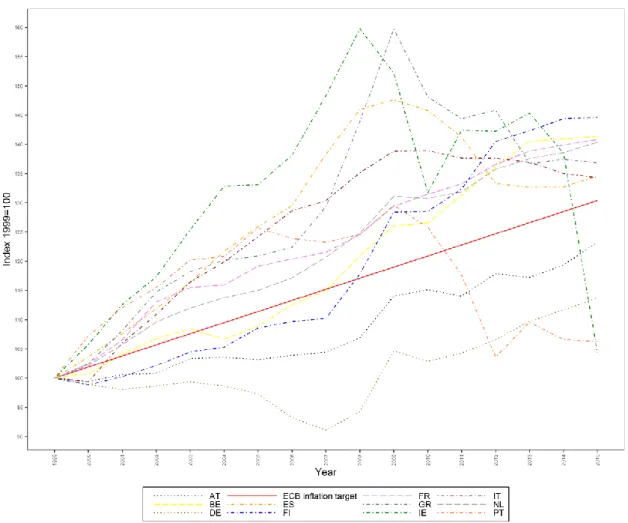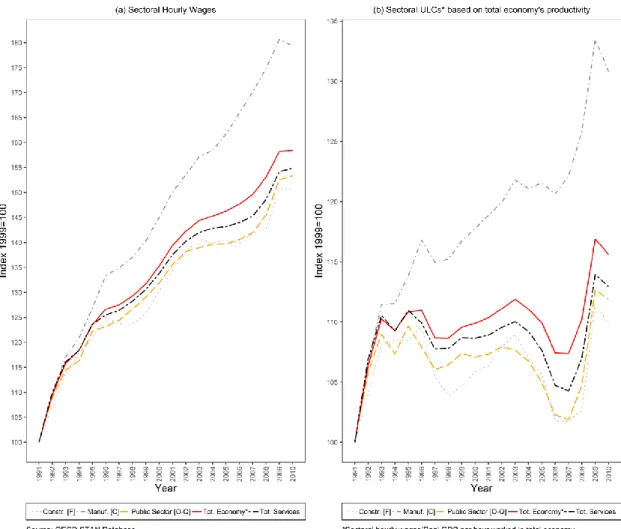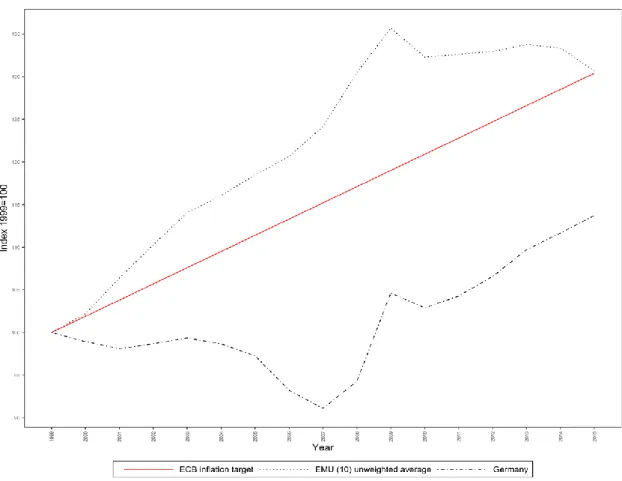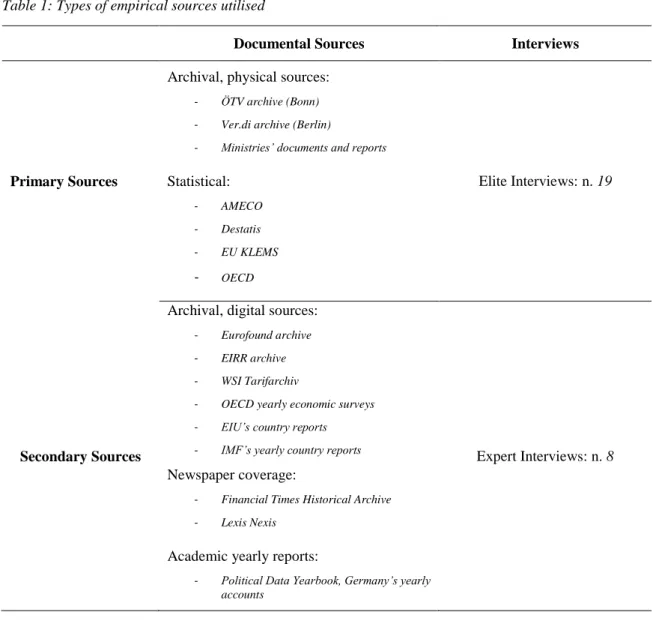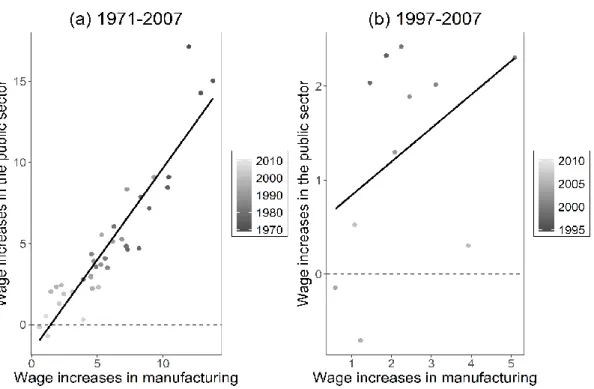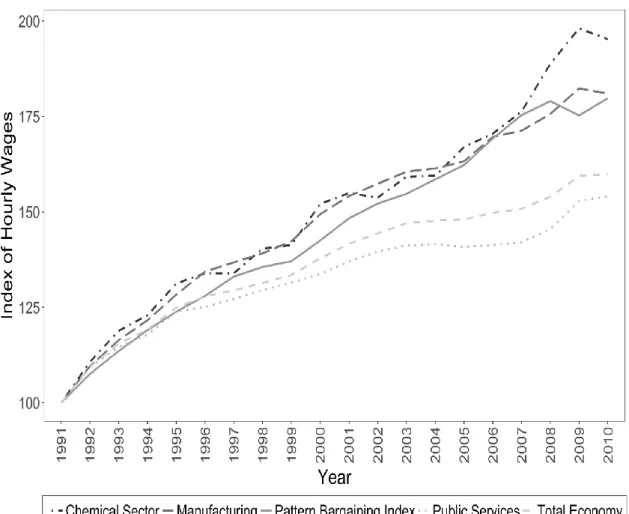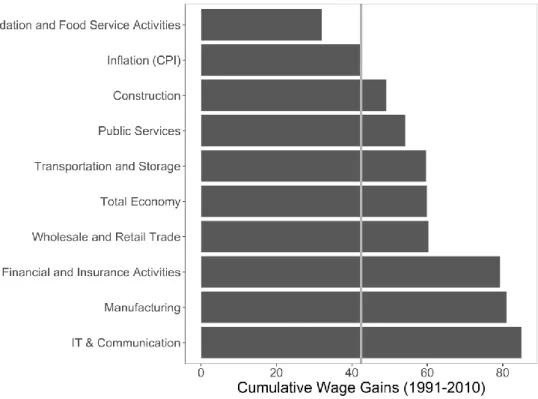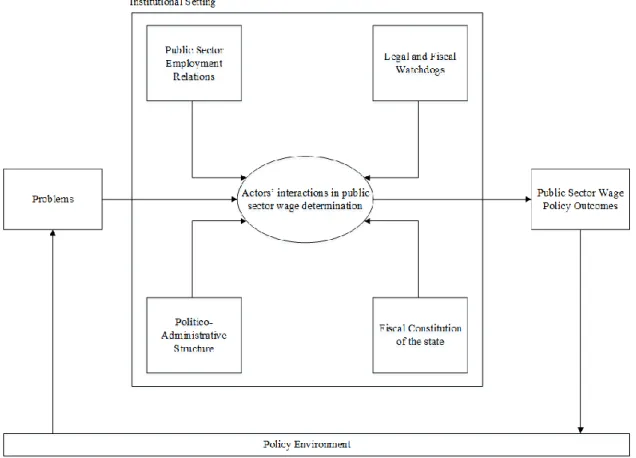Together we rule, divided we stand: public employers as semisovereign state actors and the political economy
of public sector wage restraint in Germany
Inauguraldissertation zur
Erlangung des Doktorgrades der
Wirtschafts- und Sozialwissenschaftlichen Fakultät der
Universität zu Köln
2019
presented by
MSc, Donato Di Carlo
from
Teramo, Italy
First reviewer: apl. Prof. Dr. Martin Höpner Second reviewer: Prof. Dr. Christine Trampusch Date of oral defense: 26/06/2019
i
Table of Contents
List of Figures ... iv
List of Tables ... v
List of Abbreviations ... vi
Acknowledgements ... viii
Setting the Scene ... 3
Introduction... 3
The argument of the dissertation ... 6
Plan of the dissertation ... 12
Part I. Public employers as semisovereign state actors. Toward a state-centred institutionalist framework for the study of public sector wage setting ... 14
Chapter 1. Wage policies in EMU’s public sectors ... 15
1.1 Defining wage policy options in the context of the EMU macroeconomic regime ... 15
1.2 The importance of wage policy in the EMU ... 17
1.3 The puzzle of Germany’s public sector wage restraint ... 25
1.4 Brief excursus on defining the public sector ... 29
Chapter 2. Methodological strategy of the dissertation ... 31
2.1 Logic of case selection: Germany as both an extreme and crucial case ... 31
2.2 Methodology: a two-step process tracing approach ... 34
ii
2.3 Nature, origin and storage of the utilised sources ... 38
Chapter 3. Casting the net widely: Germany’s public sector wage restraint and the study of wage determination in the social sciences ... 42
3.1 Economics ... 42
3.2 Interests-based Comparative Political Economy ... 47
3.3 Industrial Relations ... 51
3.4 Institutionalist Comparative Political Economy ... 55
3.5 Testing the rival hypothesis: does export-led pattern bargaining explain wage restraint in the German public sector? ... 59
Chapter 4. Toward a state-centred institutionalist framework for the study of public sector wage setting ... 65
4.1 Foundations of theory-guided process tracing: state-centred institutionalism as an alternative theoretical approach ... 65
4.2 Together we rule, divided we stand: public employers as semisovereign state actors... 71
4.3 Public employees and the political deterrence power ... 79
4.4 The state as an institutional contextualisation: a four-tier analytical framework for the study of public sector wage setting ... 85
4.5 Wage policy requires fiscal politics ... 92
Part 2. From reunification to a new institutional equilibrium: the trajectory of wage restraint in the German public sector ... 96
Chapter 5. The German institutional setting in the early 1990s ... 97
5.1 The politico-administrative structure of the state ... 97
5.2 Public Sector employment relations and the system of interest representation ... 100
5.3 The fiscal constitution of the state ... 106
5.4 Legal and fiscal watchdogs ... 109
iii
Chapter 6. The 1990s. Die Blühenden Landschaften hit the vincolo esterno ... 110
6.1 Reunification and the loss of fiscal and wage discipline (1990-1993) ... 110
6.2 Public sector wage restraint in the face of budget deficits (1994-1997) ... 118
6.3 Analysis of the 1990s ... 127
Chapter 7. The 2000s. The double Länder offensive: institutional and constitutional reforms of public sector wage setting ... 133
7.1 Wage restraint in the context of institutional reforms of the wage bargaining structure ... 133
7.2 Competitive federalism and civil service’s wage differentiation in the context of constitutional reforms ... 153
7.3 Analysis of the 2000s ... 160
Chapter 8. “Die öffentlichen Kassen sind immer leer“, even in the age of prosperity ... 168
8.1 A new institutional equilibrium in the German public sector ... 171
Conclusions ... 179
Public employers as semisovereign state actors and the political economy of public sector wage restraint in Germany ... 181
The fiscal mechanism of public sector wage restraint: wider implications for CPE theory and policy making in the EMU... 186
Appendix A: list of interviewees ... 213
Appendix B: dates of the signature of selected sectoral collective bargaining agreements... 214
iv
L
IST OFF
IGURESFigure 1: Inflation levels and real exchange rates (REER) across the EMU. Country clusters (1999-
2015) ... 21
Figure 2: Compensation of public employees as percentage of GDP, average of EMU countries (1995- 2016) ... 25
Figure 3: Trajectory of hourly compensation in the public sectors of EMU members (1999-2015) ... 26
Figure 4: Indexes of hourly wages in different sectors of the German economy (1991-2010) ... 28
Figure 5: Germany’s public sector wage restraint vis-à-vis EMU peers (1999-2015) ... 32
Figure 6: Correlation between wage increases (% change) in manufacturing and public services in Germany (1971-2007) ... 61
Figure 7: Indexes (1991=100) of nominal hourly wages in Germany in the export industries, the total economy, and the public sector, vis-à-vis the pattern bargaining index (1991-2010) ... 63
Figure 8: Cumulative wage gains* of workers in selected macro-sectors of the German economy vis-à- vis price inflation (1991-2010) ... 64
Figure 9: A four-tier analytical framework for the study of public sector wage setting ... 86
Figure 10: Distribution of personnel costs across the levels of the German public administration ... 103
Figure 11: Public sector employment in Germany, total and by administrative level (1991-2015) ... 104
Figure 12: Trajectory of public sector wage setting during the 1990s ... 128
Figure 13: Causal chain of public sector wage restraint during the 1990s ... 129
Figure 14: deficits of administrative levels in germany (1996-2008) ... 139
Figure 15: Trajectory of public sector wage setting in the 2000s ... 160
Figure 16: Causal chain of public sector wage restraint during the 2000s ... 163
Figure 17: Trajectory of public sector wage setting in the aftermath of the crisis ... 170
Figure 18: The fiscal mechanism of public sector wage restraint ... 188
v
L
IST OFT
ABLESTable 1: Types of empirical sources utilised ... 39
Table 2: Micro-foundations of public employers’ preferences for restraint in public sector wage setting ... 90 Table 3: The three dimensions of the new wage setting institutional equilibrium and their key characteristics ... 177 Table 4: List of interviewees ... 213 Table 5: Dates of the signature of selected sectoral collective bargaining agreements, Germany (1991–
2016) ... 214
vi
L
IST OFA
BBREVIATIONSBAT = Bundesangestelltentarifvertrag. Federal Collective Agreement for white-collar workers
BMT G II = Bundesmanteltarifvertrag für Arbeiter gemeindlicher Vewaltung und Betriebe. Federal Collective Agreement for blue-collar workers at the local level
CISL = Confederazione Italiana Sindacati Lavoratori. It is the Italian Confederation of Workers’ Trade Unions.
CME = Coordinated Market economies CPE = Comparative Political Economy
DAG = Deutsche Angestelltengewerkschaft The German Union of Salaried Employees dbb = Deutscher Beamtenbund. German Civil Servants’ Association
DESTATIS = Statistisches Bundesamt. German Federal Stitistical Office DGB = Deutscher Gewerkschaftsbund. German Trade Union Federation DPG = Deutsche Postgewerkschaft. German Postal Union
ECB = Europaean Central Bank
EIRR = European Industrial Relations Review EMU = European Economic and Monetary Union
GdED - Gewerkschaft der Eisenbahner Deutschland. Union of German Railway Employees GdP = Gewerkschaft der Polizei. Police Union
GDP = Gross Domestic Product
GEW = Gewerkschaft für Erziehung und Wissenschaft. Union for Education and Science HBV = Gewerkschaft Handel, Banken und Versicherungen. Trade, Banking and Insurance Union HICP = Harmonized Index of Consumer Prices
IG Medien = Industriegewerkschaft Medien. Media Industry Union IG Metall = Industriegesellschaft Metall. Industrial Union of Metalworkers ISIC = International Standard Industrial Classification of All Economic Activities
vii ISIC International Standard Industrial Classification
KVA = Kommunalen Arbeitgeberverbände. Association of Local Government Employers LME = Liberal market economies
MED = Macroeconomic Dialogue
MPIfG = Max Planck Institute for the Study of Societies
MTArb = Manteltarifvertrag für Arbeiter des Bundes. Federal Collective Agreement for blue-collar workers
NPM = New Public Management OCA = Optimal currency area
OECD = Organisation for Economic Co-operation and Development
ÖTV = Gewerkschaft öffentliche Dienste, Transport und Verkehr. Transport and Communication Union SGP = Stability and Growth Pact
SPD = Sozialdemokratische Partei Deutschland. German Social Democtrat Party TdL = Tarifgemeinschaft deutscher Länder. Bargaining Association of the Länder
TdL = Tarifgemeinschaft deutscher Länder. It is the employers’ association representing the interests of Länder governments in collective bargaining.
TV-L = Tarifvertrag Länder. It is the new collective bargaining framework signed in 2006 by the unions and the TdL. It regulates through collective bargaining the employment terms of public employees employed at the Länder level.
TVöD = Tarifvertrag für den öffentlichen Dienst. It is the new collective bargaining framework signed in 2005 by the unions and the municipal and federal employers. It regulates through collective bargaining the employment terms of public employees employed at the municipal and federal level.
ULC = Unit Labour Costs
Ver.di = Vereinte Dienstleistungsgesellschaft. United Services Union VoV = Varieties of Capitalism
VKA = Vereinigung der kommunalen Arbeitgeberverbände. Association of Local Government Employers.
VKA = Vereinigung der kommunalen Arbeitgeberverbände. It is the employers’ association representing the interests of municipal employers in collective bargaining.
viii
A
CKNOWLEDGEMENTSFor those like me who are in love with comparative political economy (CPE), writing a dissertation like this is a lot of fun. It is much more so if one has the privilege to work at the Max Planck Institute of the Study of Societies (MPIfG). For this, I will be eternally grateful to Martin Höpner who was the first one to believe in me in spring 2015. Martin’s guidance and expertise have been fundamental throughout the process.
There was no single day in which I could not disturb him in his office. With the benefits of hindsight, I must acknowledge that he turned out to be right in all the suggestions he gave me at critical junctures. Surely enough nothing would have been the same without him. Not only has Martin worked hard to tame my youthful animal spirits, his constant availability and kindness have made this a smoothly and joyful process. I hope this dissertation will live up to the expectations he had when he picked me as a supervisee. And he must know that, as a supervisor, he has certainly outdone mine.
But this dissertation has deeper roots. The idea of studying Germany’s industrial relations system was already rooted in me before I landed at the MPIfG. It was during my studies as a master student in London that my love for CPE and the fascination for the German political economy had developed. For this, I must thank Bob Hancké. Bob is the best teacher I have ever had. Besides, he’s fun. I would have never fallen in love with CPE if it weren’t for Bob’s class on Varieties of Capitalism at the LSE. There I learned most of the things I now like about CPE. Yet there I also learned the value of critical thinking and the importance of not shying away from intellectual debates.
Funnily enough, this dissertation ended up taking issue predominantly with his longstanding – and outstanding – contributions to the field. But this is not an act of rebellion. To the contrary, Bob’s teachings constitute the necessary condition without which this dissertation would have never seen the light. I owe my passion to his intellectual engagement. I am sure that this will be understood and live confidently with the hope that the dissertation will trigger exciting conversations.
Many people must be acknowledged in a research effort that unfolded over more than three years. Christine Trampusch has been very kind to me on several occasions.
Regretfully, we did not have the chance to interact as much as I would have loved to.
But her suggestions and teachings were always sharp and helpful and overall, she has been positive about the project from its early stage. This was important to me for I had always regarded her as one of the most solid CPE scholars. I owe to her most of my knowledge on qualitative methods in comparative research. I am extremely grateful to my two “doctoral grandfathers”. They contributed to make my experience at the MPIfG enriching and exciting. As an external supervisor, Berndt Keller accepted to follow me at an early stage. He stood behind me from the very beginning and sincerely and continuously believed in the project. Needless to say, Berndt is among the most knowledgeable scholars on the topic of Germany’s public sector industrial relations.
ix
His guidance and kindness are things I will never forget. Fritz Scharpf is unique. His most precious resource is a skill which I had never encountered before in my young life: you can walk into his room with a couple of random and messy thoughts in your mind and you can be sure to come out with a perfectly logical argument that needs only to be put “black on white”. His acceptance to follow me along this road was my greatest privilege. The attentive reader will surely notice how much of my thinking is influenced by his ingenuity. Fabio Bulfone and Nico Sonntag, honest friends and intelligent colleagues, deserve special mentioning. With them I partake of most of my working and fun time. I discussed with them all of the intuitions and the problems behind the dissertation. With great patience they read bits and parts of the dissertation and advised me on many aspects. If the dissertation’s arguments became somewhat clearer in this final version a lot of the merit belongs also to them. I am thankful furthermore to Dorothee Bohle for her hospitality during my stay at the European University Institute in Florence. This was an enriching experience in which I met many brilliant and engaged young colleagues. I learned a lot from these exchanges and I amassed important suggestions on this and other ongoing projects. I can’t possibly thank all of them here, but they know. Last but not least, I want to thank the staff of the MPIfG’s library. Without their technical support it would have been much harder to go through this.
My thanks go also to my entire family who, although not fully comprehending the entity and the importance of this effort, supported and loved me throughout. My
“gentlemen friends” scattered around London and Berlin continue to be a source of admiration and inspiration. This confirms to me that what we started in London years ago continues to be solid and meaningful, not least because of the love we share for CPE – and for disco music. Svenja Borgwardt has, unexpectedly, given me honest affection and helpful support during the last phase of writing. At the moment of writing, the hope is that she is here to stay.
This dissertation is dedicated to the German taxpayers who have financed the pleasures and the sorrows of my Deutsche Vita.
Curiosity. A good mood. No envy.
Donato Di Carlo Cologne, 27.3.2019
1
Together we rule, divided we stand: public employers as semisovereign state actors and the political economy of public
sector wage restraint in Germany
2
***
“All States are employers. Although the role of the state in LMEs is in theory more limited than in CMEs, and although in much of the world the last two decades have seen a process of privatisation of public enterprises and contracting out of public services, almost universally the majority of those working in the military, law enforcement and public administration, and at least a substantial proportion in health, education and social services, are state employees (and those who are not are nevertheless typically subject to indirect state control of their employment conditions).
This makes the state, broadly defined, the largest single employer in most countries. As a result, one may add, the simple notion of ‘three actors’ in industrial relations – workers, employers and government – is inadequate, since the state so to speak occupies two seats at the table”.
Hyman (2013, 108-09)
“Compared with the rest of the economy, the public sector is special in that the state is necessarily both a party to employment regulation and the authority that defines the rules of the game … in the public sector, the principle of collective bargaining most sharply encounters the doctrine of state sovereignty due to the dual role of the state as both sovereign power and employer”.
Traxler (1999, 57)
“The political nature of the government as the key factor leading to differences in public and private sector industrial relations is well recognised by researchers, although the precise mechanisms and means by which political forces influence public sector industrial relations structures, processes and outcomes have certainly not been identified and researched in sufficient depth and detail”.
Beaumont (1992, 12)
***
3
S
ETTING THES
CENEINTRODUCTION
There is an elephant in the European corridors. Some might say there is, again, a
“German question” in Europe. Since reunification, Germany has been held up for being both too weak first and, more recently, too strong. While it is today not so common to recall the days in which Germany was the “sick man of Europe”, it is indeed quite common to blame “it all” on Germany’s current economic prosperity. Critics of Germany often join forces with critics of the European Economic and Monetary Union (EMU). The elephant, they say, is Germany’s inconsiderate export-led strategy of economic growth, made possible by the irrevocable fixation of trading partners’
exchange rates within the monetary union. This strategy, macroeconomists explain to us, is based on repressing the domestic sector while free riding on the European peers’
aggregated demand for the accumulation of current account surpluses (Flassbeck and Lapavitsas 2013).
By joining a monetary union, countries relinquish the capacity to control exchange rates and monetary policy. Thus, the two remaining policy domains – wage and fiscal policy – have come to constitute the central pillars around which this critique revolves.
On the one hand, a trajectory of marked wage restraint throughout the German economy has produced a substantial internal devaluation which conferred on German employers a cost competitiveness premium vis-à-vis its competitors. On the other, due to an “allergy” to public spending and a weak institutional capacity to plan and implement public investments (Roth and Wolff 2018), the government’s restrictive fiscal stance has led to the accumulation of budget surpluses. The combination of wage restraint and budget surpluses contributes to repress total domestic consumption, private and public respectively. An economy with a subdued domestic sector, with both private and public consumption restrained, must eventually run at a relatively lower inflation rate. The combination of lower-than-competitors’ wage growth (measured in terms of unit labour costs’ (ULCs) inflation) and low-price inflation yields a more competitive real exchange rate (REER). In a monetary union where competitors cannot devalue their currencies, a more competitive REER is conducive to the accumulation of trade surpluses, on which the German growth model is now said to thrive (Baccaro and Pontusson 2016).
As far as we can tell, the stellar size of the German current account surplus is unprecedented and undeniable: after having reached its peak of 8.9% of GDP in 2015 it is currently projected at a 6.9% of GDP for the year 2020. The same goes for budget surpluses which have been consecutively reported since 2014 (AMECO Database).
4
This dissertation, however, has no desire to enter such a delicate debate on the merits and normative desirability of the German macroeconomic model in the EMU. Much has been written in this regard by other Comparative Political Economy (CPE) scholars and the debate, far from having been settled, seems just about to kick off. What is of relevance for the purpose of this dissertation is the fact that what lies at the heart of Germany’s adjustment process – through which the country has gone from being considered the sick man of Europe to becoming its “economic superstar” (Dustmann et al. 2014) – is a trajectory of marked wage restraint. The driving motive behind the dissertation is that during this long process of internal devaluation, various things which occurred seem to have gone unnoticed by many. The research effort takes off from the following empirical observation. Since the inception of the EMU (and actually throughout the 1990s), a pattern of wage restraint1 in Germany has indeed occurred in the private sector. But it is in the public sector where the most remarkable trajectory of wage restraint can be detected (Di Carlo 2018a; Müller and Schulten 2015) (see also figures 4 and 5). As the literature review will show, while much has been written on the private/export sector, very little is known about structures, processes and outcomes of public sector wage setting, in Germany and beyond. The subject matter of this dissertation is therefore the study public sector wage setting, in theory and in practice.
In assessing the importance of public sector wages in the EMU, we learn from previous studies that current account imbalances in the single currency were significantly associated with the divergent trajectories of members’ public sector wages (Johnston 2016; Johnston, Hancké, and Pant 2014). In fact, public sector wage trajectories among the EMU participants diverged substantially after 1999 (figure 5). Countries which successfully kept public sector wage inflation under control remained relatively more competitive within the monetary union, accumulating trade surpluses; and vice versa (Hancké 2013). Public sector wage growth has been proven to affect private sector wage growth (Afonso and Gomes 2008). With regard to the period before the crisis, economists have found a strong positive correlation and co-movement between public and private sector wages which, in a number of EMU countries, coincided with strong public wages’ growth and losses of overall competitiveness (Holm-Hadulla et al. 2010).
In this sense, the divergent growth trajectory of countries’ public sector wages has contributed to exacerbate the process of countries’ structural ULCs divergence which a variety of studies considers as the Eurozone crisis’ culprit (Flassbeck and Lapavitsas 2013; P.A. Hall 2012; Hancké 2013; Höpner and Lutter 2014; Iversen and Soskice 2013; Johnston 2016; Johnston, Hancké, and Pant 2014; Johnston and Regan 2014;
Scharpf 2011).
1 By wage restraint here I mean nominal wages, discounted by total labour productivity in the economy, which grow slower than the common ECB’s inflation target of “below but close to 2%”. This formulation refers to the golden rule of wage bargaining which will be discussed in greater detail in due course.
5
Public sector wage setting becomes all the more interesting for countries of the EMU if we furthermore consider that, since public wages are paid out of governments’ budgets, public sector wage policy is a major item of fiscal policy. In other words, public sector wage policy is a subset of the government’s overall fiscal stance. Public sector wage policy is thus a unique policy space in the present European macroeconomic regime where the only two policy domains left under the remit of national and democratically elected governments coincide. As a result of the notable size of the wage bill in public budgets (figure 2), looking at the convergence/divergence of public sector wage policy among the members of the union is therefore an interesting way to look at countries’
coordination of fiscal policy within the EMU. In relation to these considerations, studies have found that public sector wage policies, before the crisis, contributed to intensify pro-cyclical fiscal policies across the EMU members, pushing apart country- specific economic cycles (Holm-Hadulla et al. 2010).
We know, in other words, that public sector wage setting matters in different ways within the macroeconomic regime of the EMU. Yet what we do not know is what explains the adoption of these national public sector wage policies in the first place. As a first step in starting to address this wider question, in this dissertation I have selected the German case of public sector wage restraint because it satisfies the conditions of an extreme and crucial case study with substantial real-world implications. The dissertation looks at the German case in between two historical junctures, German reunification in 1990 and the financial crisis in 2008.
Germany is extreme because the entity of the public sector wage restraint which needs to be explained assumes extreme values in the mid-2000s. Within the divergent growth trajectories of members’ public sector wages which can be observed since the inception of the EMU (figure 5), it is the only country that pursues such a remarkable pattern of restraint. It is an outlier in this respect. Moreover, Germany is a crucial case for the scholarly literature because it constitutes a most-likely case in which to expect an explanation of public sector wage restraint based on the established pattern bargaining thesis. This argument, I will show, cannot be validated in the very crucial case for which this theory has been popularised in the first place. In fact, what I term “the pattern bargaining hypothesis” maintains that public sector wage restraint in Germany is ensured via the country’s specific wage bargaining institutions through which public sector’s wage growth is pegged to that in the export sector, ensuring overall wage restraint across the economy. It will be shown that this explanation does not withstand the test of empirical observation, leaving us in the dark as far as our understanding of public sector wage restraint in Germany is concerned.
This dissertation thus addresses the following central question: what explains Germany’s trajectory of public sector wage restraint vis-à-vis its EMU peers? Posing this question has both policy relevance and theoretical importance. With regard to the former, the dissertation speaks to the necessity of finding an answer to the bigger question which has implications for the smooth functioning of the EMU, namely: why
6
have countries which were subjected to the same hard monetary regime experienced such divergent trajectories of wage growth in their public sectors? Working out an answer for the German case is crucial because Germany is the most populous member and most powerful (politically and economically) actor at the heart of the single currency. Theoretically, asking this question assumes importance in light of the failure of the pattern bargaining hypothesis in explaining Germany’s public sector wage restraint. In fact, the theoretical question the dissertation poses in light of this failure is the following: if we cannot explain Germany’s public sector wage restraint through the theory of inter-sectoral wage coordination via export-led pattern bargaining, what other factors, so far unaccounted for, explain Germany’s trajectory of public sector wage restraint? In answering this theoretical question this dissertation will not only challenge a dominant theory in the field of both CPE and industrial relations studies. It will also provide a more accurate historical and institutional explanation for the case at stake with the hope to produce new information that shall add incrementally to our current stock of knowledge on public sector wage setting and industrial relations more generally.
To answer these questions, the dissertation will employ a two-step process tracing methodology. I blend together elements of deductive and inductive process tracing. As a first step in the explanatory effort, I proceed with theory testing process tracing to test the validity of extant explanations for the case at stake. Subsequently, after having refuted alternative explanations, I proceed with a more inductive type of theory-guided process tracing for the purpose of explaining the German case of public sector wage restraint.
THE ARGUMENT OF THE DISSERTATION
In line with actor-centred institutionalism (Scharpf 1997b), on which this dissertation draws, I distinguish between phenomena’s proximate and remote causes. Proximate causes behind the adoption of given policies are to be found in the actors’ interacting choices while institutional conditions are treated as remote causes in that they provide the institutional structures within which these policy choices are made (Scharpf 2000, 764).
The proximate cause behind Germany’s trajectory of public sector wage restraint vis-à- vis its EMU peers, I posit, is the public employers’ necessity to achieve fiscal consolidation through wage restraint given the lack of fiscal autonomy on their fiscal revenues’ side. Through public sector wage setting, the German public employers went on the offensive against the unions in order to rein in the fiscal costs of wage setting in the public administration. To save money, they also attacked all other aspects of the employment relation as well. They managed to extend working hours, to merge and reduce bonuses, curtail holiday and overtime payments so that wage restraint was but one dimension of this strategy of consolidation. The public employers’ necessity for
7
fiscal consolidation, however, is not homogeneously distributed among the three German public employers (i.e. the Federal, the States and municipal levels). This is because it is mediated by the institutional configuration of the German state. Three institutional domains structure wage setting interactions in the public sector and shall therefore be considered remote causes behind Germany’s pattern of restraint. These are:
the fiscal constitution of the German state, which regulates the public employers’
capacity to raise revenues; the structure of the politico-administrative system which defines the organisation of the polity and the distribution of legal competences and public personnel within it; the system of public sector employment relations and interest representation which regulates the process of wage determination in the public administration.
On the revenues’ side, Germany’s fiscal federalism system is unique. Its central feature is the centralisation of tax legislation at the federal level in addition to the Länder’s legal capacity to veto tax legislation in the Bundesrat. This means that, neither the Federation nor each Land alone can independently manipulate their tax revenues at will. The structure of fiscal revenues is thus rigidly fixed according to pre-decided formulae which, to be changed, require a negotiated change of the constitution capable of winning hard-to-achieve qualified majorities. On the expenditures’ side, the asymmetric distribution of competences decreed by the German constitution yields an asymmetry in the stock of labour costs which the different German employers face.
While the Federation has mostly legislative competencies, most of the administrative competencies lie within the remits of the Länder and the municipalities. As a result, within the German politico-administrative system, the bulk of public employees are employed by Länder and municipal employers. The interaction effect between a legally constrained fiscal autonomy and an asymmetric distribution of personnel costs has created scope for fatal conflicts of interests among the public employers. Public sector wage setting in Germany is regulated by a hybrid system of public sector employment relations. Public employees are regulated through collective bargaining. Here wage restraint could be pursued thanks to public employers’ strength in the face of unions’
structural weaknesses. A weak mobilisation capacity among Länder’s public employees and dynamics of privatisations and outsourcing of municipal services have undermined the capacity of public sector’s unions to hold out against the employers’ offensive.
Civil servants are instead subjected to the state’s sovereign authority. Here wage restraint could in theory have been pursued via unilateral legislation. Yet, in practice, this could rarely be the case because public employers were internally divided. Thus, I argue, the state’s sovereign authority in public sector wage setting is de facto not absolute but contingent: it can only be deployed under the condition that public employers overcome their internal dividedness.
In rebuttal of the “pattern bargaining hypothesis” which sees public sector wage restraint as a by-product of export sector’s dominance in inter-sectorally coordinated wage bargaining across the economy, this dissertation argues that the public employers
8
are crucial state actors who are no subaltern to a producer groups’ coalition in the German export sector. In other words, I suggest that the state should not be thought of as a mere executor of the economic affairs of “dominant” producer groups in the export sector. Implicit to these arguments there lies an understanding of the German state as a monolithic bloc capable of frictionless unitary action, which export sector’s actors can capture. However, there is no such thing as a German government. Germany is a
“semisovereign state” characterised by a fragmented polity in which political authority in important policy areas, most notably public sector wage policy, is assigned to or shared with the sub-national governments which compose the Federation. Thus, to paraphrase Katzenstein (1987, 16), the “federal government has no choice but to negotiate and cooperate with centres of state power over which it has no control”.
Hence, if there is no single centre of political power in the German political economy, there must be no single political entity over which export sector wage setters can so smoothly exert their dominance. This complicates matters.
The dissertation argues that the state is not a neutral actor in public sector industrial relations. Nor is it a mere instrument of a dominant social bloc in the export sector, as implicitly assumed in these arguments. The state matters and is crucial for the study of public sector wage setting. But who and what is the state? I posit that the state should be understood as an institutional contextualisation. The state does not act in public sector wage setting. Public employers do; within the legal and institutional contours of the state. Modern States are fragmented and decentralised. They are ensembles of multiple institutional entities and centres of political power each with its own interests, preferences and strategies. Nothing ensures us that these interests will be aligned among themselves, nor that they will be aligned with those of an export sector’s elite.
Rather, States’ fragmented nature creates scope for intra-state conflicts of interests in policy making. Public sector wage setting in Germany is a case in point. What characterises the German public employers is, in fact, their internal dividedness. So the state matters. But it is not a unitary actor. Through a detailed historical reconstruction, it will be shown that the public employers follow their own logics which are fully independent from the export sector producer groups’ necessity to ensure the competitiveness of German goods in international markets. Quite to the contrary, the dissertation shows that in different occasions, militant unions in the German export sector managed to break up with the pattern of moderation started in the public sector and push their pay settlements up. For the public employers these expensive patterns created headaches. While the public employers were desperately trying to save money through public sector wage restraint, at times the export sector’s patterns forced them to revise upwards their initial meagre pay offers. In other words, the public sector unions could point at the generous export sector settlements and play the pattern against the stingy public employers. Thus, I posit that public employers’ interests are rooted in the organisational imperatives of the state institutions they represent. At their core, these
9
interests are fiscal in nature, i.e. the public employers must guarantee the financial soundness of the public organisations they are responsible for.
The story of public sector wage setting in post-reunification Germany is a story of a political misalignment within the public employers’ wage bargaining coalition. For more than forty years, a wage bargaining coalition (Tarifgemeinschaft) stipulated by the three public employers of the German administrative system (the Federation, the Länder and the municipalities) had ensured unity in collective bargaining negotiations.
As a result, public sector wage setting in Germany (differently from the private sector’s) had for long been centralised and encompassing under the formal leadership of the federal Minister of the Interior. This guaranteed uniformity of employment conditions and pay terms across the country. Similarly, civil servants’ pay determination, which in Germany is part of a separate legal sphere, had for long remained a legal competence in the remit of the federal government. Thus, the fact that until 2006 the federal level set the terms of employment and pay has ensured uniformity across the country’s civil service at all levels of government. The two distinct legal spheres were kept coordinated via a system of intra-public-sector pattern bargaining. The pay settlements negotiated through collective bargaining were then transferred to the civil servants via legislation drafted by the Ministry of the Interior and approved by the federal parliament.
Reunification dealt a blow to the finances of the German public employers. This coincided also with a prolonged period of slow economic growth and high unemployment not least because of the Bundesbank’s decision, in the early 1990s, to severely tighten monetary policy. After the inflationary pressures which followed reunification, through a stop-go type of monetary policy, the Bundesbank intended to
“punish” policy actors for the loss of fiscal and wage discipline. The central bank did not digest the government’s expansionary fiscal policy, the wage setters’ exuberance and the government’s weak stance in public sector wage setting. The economic recession which ensued meant lower tax revenues, higher social expenditures and an increasingly tighter fiscal space available to public employers. The tighter the fiscal space grew, the more constrained the public employers’ ability to pay became. In winter 1996, when Germany risked missing the 3% deficit rule agreed in Maastricht, the public employers united behind the leadership of the federal Finance Minister Theo Waigel. In order to achieve fiscal consolidation the public employers pushed aggressively for a two-year “zero wage round” in the public sector. The unions caved in but, in the process, managed to obtain a modest pay settlement instead of a wage freeze and cuts in sickness pay. Public sector wage restraint was instrumental and perhaps fundamental for Germany to comply with the Maastricht criteria by 1997. This is because the Social Democratic Party (SPD) in opposition and the Länder governments were blocking other cost-cutting measures through the Bundesrat. In all, the three governmental levels remained united within the public employers’ coalition throughout
10
the 1990s and, in pushing through a fierce pattern of restraint in 1996, supported the firm stance of Theo Waigel.
With the collapse in tax revenues caused by the Schröder’s tax reform (especially the 2001 step), the public employers’ fiscal space grew tighter and tighter in the 2000s.
Germany was being held up as the sick man of Europe. At the same time it remained under the radar of the European Commission for its consecutive breaches of the 3%
deficit rule. Within this context of financial hardship, a political conflict emerged among the public employers which eventually led to the partial decentralisation of public sector collective bargaining. With their finance in dire straits, in 2003 the Länder governments decided to pull out of the historical public employers’ coalition. This decision was primarily rooted in the disproportional stock of personnel costs the Länder public employers face. This is due to the asymmetric distribution of administrative competencies which the German constitution assigns to sub-national governments. This asymmetric distribution of labour costs is made irremediably problematic by the centralisation of tax legislation which characterises the German fiscal federalism system. As a result of the lack of fiscal autonomy, the Länder could not adjust their revenues in the face of structurally rising costs of public sector wage setting.
By threatening to leave their Länder employers’ association (TdL), the States forced it to quit the wage bargaining coalition with the Federation and municipalities. In so doing, they pushed instead for the institutionalisation of a new system of Länder-level collective bargaining (the TV-L contract agreed in 2006). This was meant to contain the fiscal costs of their personnel expenditures by escaping the leadership of the federal level in wage negotiations. Also, it consisted of a strategic move to “get rid” of the municipal employers. The municipal level had always been the weak chain of the bargaining coalition due to the employers’ fragility vis-à-vis workers’ militancy in key infrastructural services (e.g. local transport, waste disposal, etc.). In parallel to the overhaul of the hitherto centralised collective bargaining framework, the Länder also succeeded in obtaining the return of the legislative competence on their civil servants’
careers and pay. This occurred within the context of the reform of the German fiscal federalism in 2006.
The federal and municipal employers decided instead to stick together and negotiated a new joint collective bargaining framework (the TVöD contract agreed in 2005) with the trade unions. The condition for the municipalities to remain together with the Federation was that the design of the TVöD be premised on the need of municipal employers (represented by VKA) to reduce the costs of public services’ provision in the face of ever tighter budgets. The unions went along with the municipal employers’
desires under the serious threat of privatisations and outsourcing of municipal services.
In fact, during the 2000s, the trade unions were pushed on the defensive in all these processes and had to compromise with concessionary bargains. They preferred to compromise rather than see the whole collective bargaining edifice disintegrate. The
11
two-tier collective bargaining system to which they agreed, although a second best for them, is still to be preferred to the full collapse of collective bargaining.
Wage restraint was pursued throughout this period in the form of extended working hours, benefits’ cuts and meagre lump sums. These were conceded to the unions (during the period 2005-2008) in exchange for their agreement to the reforms. To maintain the collective bargaining framework alive, the unions needed – and still need – the public employers to remain united as a negotiating partner. Paradoxically, since the unions need united public employers more than the employers actually wish to be together (due to their internal conflicts of interest), the political divisions among the public employers ended up strengthening their bargaining power: were the unions not to accept public employers’ demands for fiscal savings, employers would pull out of their associations and collective bargaining would collapse, making bargaining unmanageable for the unions.
Eventually, the result of this parallel process of institutional and constitutional changes has led to the institutionalisation of what I term a “low-wage institutional equilibrium”
in public sector wage setting. This is a situation in which public sector wage policies in Germany can only be set as a lowest common denominator which negotiators must find by calibrating public sector wage policies according to the poorer employers’ ability to pay. Thus, this institutional setting creates a structural bias toward wage restraint in public sector collective bargaining. By equilibrium I mean, specifically, a situation in which no actor has an interest in challenging the status quo. Each of the three public employers benefit from the current institutional configuration, although in different ways. This is clearly an employers’ friendly status quo which the unions can only challenge at the risk of ending up in an even worse situation, i.e. the complete collapse of collective bargaining in the public sector. For the unions, the current institutional configuration represents a second best which is worse than the status quo ante when the system was centralised and encompassing. But the current system is anyway better than atomistic and fragmented bargaining. This equilibrium, I argue, currently prevents the pursuit of policies of public sector wage/fiscal inflation which may be desirable to reflate the German economy and provide a more symmetric adjustment within the EMU. The equilibrium consists of three complementary legal dimensions of which Germany’s public sector wage setting is now composed: the TVöD contract which regulates public employees at the federal and municipal level; the TV-L contract which regulates public employees at the Länder level; the legal competence on civil servants’
pay which is now within the remits of each of the Länder’s legislators.
Within the TVöD, the only wage policies which can obtain a majority in the VKA’s Mitgliederversammlung (members’ general assembly of municipal employers), are those which are calibrated according to the poorer municipalities’ ability to pay. Even assuming an inflationary policy would somehow make it through a majority, were this policy to be too expensive, poorer municipalities would sooner or later leave the VKA.
12
This is possible because membership is voluntary. This means wage policies need to be set as a lowest common denominator between the poorer and richer municipalities and the federal level. Since the federal level knows that wage policies beyond the poorer municipalities’ ability to pay will produce a stalemate of the whole wage bargaining machinery, during normal times, it converges by default on the VKA’s internal need to accommodate various stakeholders. This creates a structural downward tendency which prevents the pursuit of policies of public sector wage inflation in the TVöD.
In the TV-L contract poorer and richer Länder negotiate together within the TdL. Both types of Länder have an interest in a lowest common denominator wage policy calibrated on the poorer Länder’s ability to pay. Through horizontally coordinated bargaining the rich States obtain fiscal savings which they can divert to other uses. This is because a lowest common denominator brings about wage policies which are cheaper than the settlements they would have to pay were they to negotiate freely in a fully competitive labour market. Richer Länder have, so to speak, an “interest in being outvoted” by poorer ones within the TdL. The poor Länder instead avoid a system of competitive federalism in which they would lose out against the richer Länder’s greater ability to pay. The attainment of the legal competence on civil servants’ careers and pay by the Länder squares the circle. It gives richer Länder the possibility to deviate in melius from this low-wage equilibrium. In Germany the private sector is generally a more attractive employer and public employees are a scarce resource. Richer Länder’s employers who need to compete with the private sector in their local tighter labour markets need a flexibility valve. They need to have the possibility to deviate from these contracts upward in order to remain attractive employers. Since the decision on the legal status of the newly-hired falls on the employers, richer public employers with a greater ability to pay, who need to be more attractive recruiters, can offer better terms of employment through the “civil service valve”. This has led to a fragmentation of civil servants’ career structures across the country. Pay differentials in the civil service now stand at around 11% between Berlin (the poor) and the Bavaria (the rich).
PLAN OF THE DISSERTATION
The dissertation is structured around two parts. Each of them has four chapters. Part one is more theoretical in nature. Part two is empirical and deals with the case study.
Part one deals with issues of conceptualisations, theory and methodology. In chapter one I conceptualise the outcome of public sector wage setting deriving it from macroeconomic theory. I then discuss the importance of public sector wage policies within the macroeconomic regime of the EMU and explain the puzzle of Germany’s public sector wage restraint. In chapter two I deal with the methodological approach of the dissertation. I explain the logic of case selection, the type of process tracing employed and the sources utilised. In chapter three I perform a wide literature review in
13
line with suggestions from the best practices of process tracing (Bennett and Checkel 2015; Trampusch and Palier 2016). I “cast the net widely” in search for explanations and other useful insights, relevant for the case of interest. Before concluding the chapter I test empirically the main rival explanation. This leads me to refute it and move forward in the search for an alternative explanation. In chapter four I thus introduce the alternative theoretical approach of the dissertation and discuss theoretical aspects which characterise the key actors involved in public sector wage setting: the public employers and the public sector’s unions. Subsequently, I introduce an analytical framework which theorises the state as the institutional contextualisation within which public sector wage policies are enacted. Lastly, I discuss why to fully understand public sector wage setting we should trace it back to the politics of fiscal policy.
Part two puts the framework into action and proceeds with the empirical analysis of the German case. In chapter five I describe the peculiarities of the German institutional setting. The subsequent two chapters engage with the historical reconstruction of public sector wage setting in Germany. Chapter six covers the 1990s. Chapter seven covers the 2000s. Each of these chapters is concludes with an analytical section in which I reflect critically on what could be observed during the historical reconstruction in light of what could be expected on the basis of the literature review. Chapter eight then discusses in greater details the micro-foundations and the institutional logics of the new institutional equilibrium which has emerged after 2006.
In the conclusions I do three things. First, I wrap up the findings of the case study.
Secondly, I elaborate on the theoretical aspects of the causal mechanism which this dissertation has uncovered and discuss the scope conditions of what I have termed: “the fiscal mechanism of public sector wage restraint”. By briefly contrasting these findings with the Italian case of public sector wage inflation, I discuss why the mechanism I have uncovered maintains its explanatory power only within the scope conditions of cases of public sector wage restraint. Thirdly, I conclude the dissertation by discussing the wider implications of the dissertation’s findings for the recent turn toward growth models research in CPE. Furthermore, I briefly hint at the implications of the identified institutional equilibrium for Germany’s capacity to offer a more symmetric adjustment in the EMU through wage/fiscal reflation. Alas, my tentative answer is negative.
14
P
ARTI. P
UBLIC EMPLOYERS AS SEMISOVEREIGN STATE ACTORS. T
OWARD A STATE-
CENTRED INSTITUTIONALISTFRAMEWORK FOR THE STUDY OF PUBLIC SECTOR WAGE SETTING
15
C
HAPTER1. W
AGE POLICIES INEMU’
S PUBLIC SECTORSThis chapter is theoretical in nature. The purpose is to introduce and conceptualise the outcome to be studied. Starting from the golden rule of wage bargaining, in sub-section 1.1, a taxonomy composed of three alternative wage policy options is derived. The typologies of policy options serve as the analytical tool for the analysis to be executed in the dissertation. This exercise is in fact preparatory to conceive of the outcome to be explained, i.e. public sector wage restraint. Sub-section 1.2 then discusses the importance of public sector wage policies for the macroeconomic regime of the EMU.
In light of these theoretical considerations, sub-section 1.3 presents the puzzle of Germany’s public sector wage restraint within the EMU, clarifying why solving this puzzle has both policy implications and theoretical relevance. Lastly, in sub-section 1.4 I provide a definition of the public sector, i.e. the economic arena in which public sector wage restraint will be analysed.
1.1 DEFINING WAGE POLICY OPTIONS IN THE CONTEXT OF THE EMU MACROECONOMIC REGIME
The aim of the dissertation is to explain a specific type of policy outcome, namely public sector wage restraint. Doing so implies explaining choices in the conduct of public sector wage policy. To accomplish the task, a typology of policy alternatives is needed to define the set of possible courses of action (policy options) (Gourevitch 1986) from which any wage setters may choose. This means to conceptualise and define the qualitative outcome to be explained.
There exist two ways of conceptualizing a typology of policy alternatives: via deduction or via induction (Van Evera 1997). In the EMU context, given the available literature, this can be done deductively by resorting to the concept of the golden rule of wage bargaining. The golden rule is an analytical construct derived from macroeconomic theory which acquired great importance at the launch of the EMU. The golden rule was meant to provide a “soft” functional equivalence for the lack of pan- European wage coordination and ensure macroeconomic governability of the EMU. By resorting to this concept, it is thus possible to deduce the taxonomy of policy options.
According to the golden rule, nominal wages ought to be set in line with the sum of the common inflation target in the monetary union (the ECB’s “below but close to 2%, i.e.
1.9%) and the rate of national average labour productivity.
16
Golden rule:
(1) ∆% nominal wage = 1,9% + Δ avg. Labour Productivity
Starting from (1), two alternative wage policies which diverge from the golden rule can be defined. When the rate of increase in nominal wages (∆%) overshoots the golden rule (upward divergence from the benchmark) we shall treat these as policies of wage inflation. When ∆% undershoots the golden rule (downward divergence), we shall consider these as policies of wage restraint. As a result, from (1) we can derive the formulation of the two policies.
Policy of wage inflation:
(2) ∆% nominal wages − ∆% avg. labour productivity > ECB’s inflation target
Policy of wage restraint:
(3) ∆% nominal wages - ∆% avg. labour productivity < ECB’s inflation target
In theory2, public sector wage setters can thus choose to adopt three alternative types of wage policies in the public sector:
i. Policy of the Golden Rule ii. Policy of wage inflation iii. Policy of wage restraint
The policy outcomes are conceived here as qualitative ones with characteristics which make them exclusive categories: wage inflation and wage restraint consist of bi- directional types of divergence from the theory-deducted benchmark. Two clarifications are of order. First, since I am interested in understanding structural divergence of wage setting outcomes in the public sector, the qualitative outcome I aspire to explain consists of trajectories rather than individual yearly bargains per se.
This leads me to categorise a country’s trajectory as inflationary or deflationary depending on whether public sector wage developments diverge from the benchmark in a systematic way. Secondly, since wage setting in the real world is not such a neat exercise as it is described in theory, to make the taxonomy useful (and meaningful) in practice, it is necessary to grant an “error margin” to the conceptualisation of the wage policy. In this way, countries with public sector wage trajectories more or less in line
2 Given the difficulty of calculating productivity in most public services and given the absence of a market to determine prices, every such attempt to devise an analytical construct of this kind will remain open to criticism. Nevertheless, so far, the so-called Golden Rule remains the best available option, as a composite of the inflation rate (wage floor protecting real purchasing power) and average labour productivity (determining a “fair” wage ceiling based on the average productivity of all workers in the economy). Its importance also stems from the real-world importance which policy makers attached to it at the beginning of the EMU.
17
with the benchmark can be considered as pursuing policies of the golden rule even when they do not neatly coincide with the mathematical calculation of the golden rule.
This, however, is not a problem for the German case of interest here which is, unequivocally, a case of public sector wage restraint.
This way of proceeding necessarily creates room for subjective choices to be made. As such, they shall be open to debate. At the same time however they shall be excused on the grounds of making abstract concepts applicable to the real world for analytic purposes. These wage trajectories are, in other words, conceptualised as ideal types necessary to guide us in the empirical inquiry. Most importantly, it should be clear from the beginning that I do not assume that wage setters do necessarily understand, accept and follow the golden rule when setting public sector wages in the real world.
Yet the concept of the golden remains analytically important for two reasons. First, for positive analysis, it is the analytical benchmark that makes the operationalisation of the dependent variable meaningful in the context of the macroeconomics of the EMU.
Second, and consequently, from the perspective of normative analysis, setting this benchmark allows us to establish and understand cases which, from the perspective of economic governance in a monetary union, deviate from policy outcomes which would be desirable under the conditions of the EMU. Germany is precisely one of these cases.
Of the three outcomes conceptualised, the dissertation will embark on explaining only one type of public sector wage policy, namely public sector wage restraint in post- reunification Germany. This is because, given the centrality of the German case for both academic theory and policy making in the EMU, Germany requires an inquiry on its own. The following sub-section elaborates on the importance of public sector wage policy within the macroeconomic regime of the EMU.
1.2THE IMPORTANCE OF WAGE POLICY IN THE EMU
Capitalist economies are inherently unstable and the recurrence of economic shocks is a fact of economic life (Minsky 2008 (1986); Wray 2016). As it has long been recognised, governments’ intervention aimed at correcting unstable markets is a necessary function in modern economic systems (Keynes 1936; Musgrave 1959).
However, by joining the EMU, the control of crucial instruments of macroeconomic management is removed from the hands of democratically accountable governments (Scharpf 2011). This complicates matters.
Adjusting to the fluctuations of capitalist cycles requires either a “mechanical adjustment” or a “policy-induced adjustment” (Enderlein 2006). The former means that changes in economic fundamentals will trigger a self-enforcing adjustment which, over time, will reinstate equilibrium in the economic system. The latter means that policy authorities intervene to correct the functioning of the market economy to induce the correction of disequilibria. This entails policy makers’ use of stabilisation policies.
18
In theory, there exist four standard policy instruments for macroeconomic stabilisation (Hancké 2013, Ch.5; Scharpf 1991). Fiscal policy, which can be of restrictive and expansionary nature, depends on whether the government subtracts from or adds to the economy fiscal resources, defined as the difference between total revenues and total expenditures. Monetary policy can also be restrictive or expansionary. In today’s monetary policy frameworks it entails the setting of interest rates by the monetary authority so as to steer the economy toward its statutory-mandated inflation target (Carlin and Soskice 2014; Ch. 13). Exchange rate policy consists of devaluations or revaluations3 of a country’s nominal exchange rate. This is tantamount to adjusting the price of a country’s currency to one’s convenience. Wage policy, which is also expansionary or restrictive in nature, depends on whether the determination of wages between employers and employees leads to real wages that grow faster/slower than productivity rates.
Joining a monetary union does bring with it costs and benefits. The benefits are mostly concentrated at the microeconomic level. It is generally accepted that monetary integration stimulates higher trade and investment by increasing economies’ allocative efficiency though enhanced economies of scale and lower transaction costs; that cross- national competition in goods and labour markets brings efficiency gains; that monetary union increases the liquidity of financial markets (Carlin and Soskice 2014, 430). A monetary union reduces the exchange rates’ volatility characteristic of systems of flexible exchange rates. In so doing, it also eliminates the political conflicts which ensue from exchange rates’ adjustments (Höpner and Spielau 2015) and precludes the emergence of poisonous competitive devaluations across nations. Through the delegation of monetary policy to an independent supranational bank, the EMU also helps countries to stabilise their inflation rates and to bring down interest rates on governments’ borrowing. This was particularly beneficial for some of the European economies which had for long time struggled to keep inflation and borrowing costs under control.
Yet joining a monetary union entails severe costs. These are related to the loss of sovereignty over the policy instruments which are generally used for the stabilisation of the economy. Economists have maintained that these costs are greater the less the monetary union resembles an “optimal currency area” (OCA) (Kenen 1969; McKinnon 1963; Mundell 1961). If the economic cycles of participating countries were fully synchronised – as they should in an ideal OCA – then supranational monetary policy would help restore equilibrium in the face of a commonly experienced shock. In the case of a country-specific shock instead, countries with no monetary independence will dispose of no possibility to adjust neither through monetary nor exchange rate policies.
If wages were flexible enough and/or if the labour force were sufficiently mobile to
3 This depends on the monetary regime. In a flexible exchange rates system: depreciations and appreciations.
